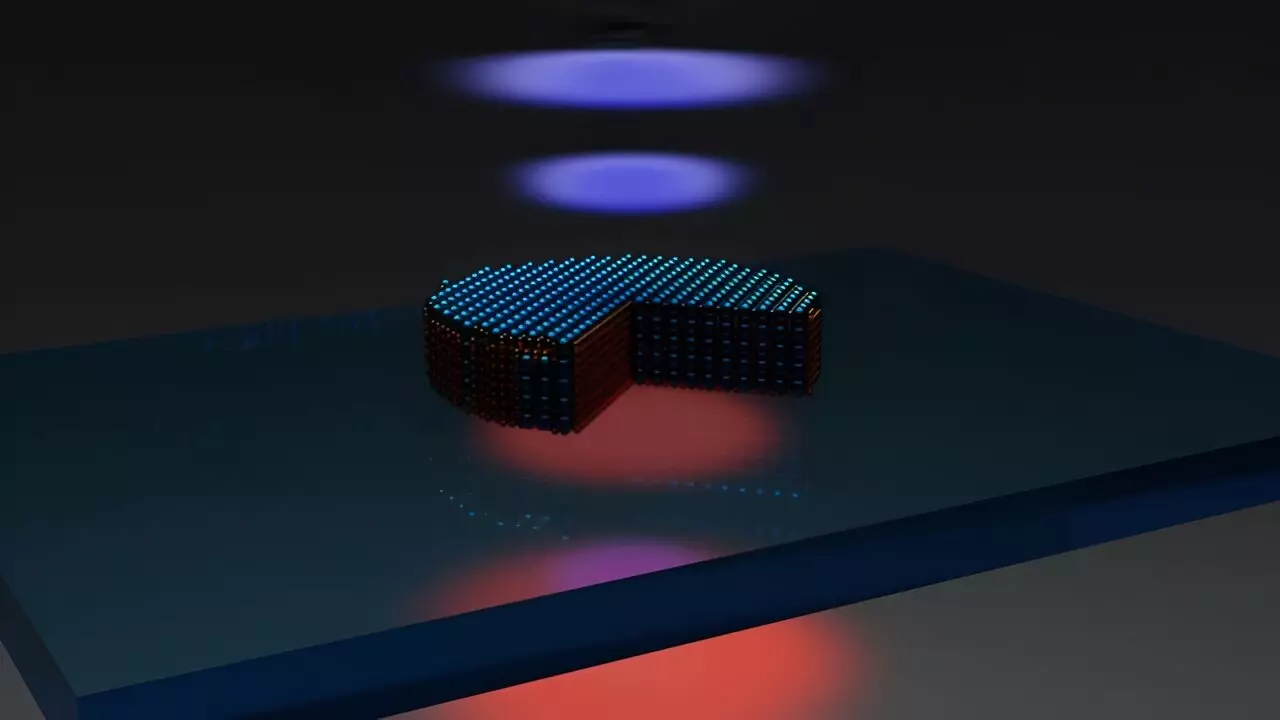The vast potential of photonics lies in its ability to manipulate light-matter interactions, leading to significant advancements across several disciplines, from telecommunications to medical diagnostics. Researchers continually seek to harness these interactions to develop innovative technologies, pushing the boundaries of what is possible. Recent breakthroughs at Chalmers University of Technology have melded two pivotal research arenas—nonlinear optics and high-index nanophotonics—into an unprecedented disk-shaped nano-object, opening new avenues in optical technology.
Led by Dr. Georgii Zograf, the team’s research has culminated in an incredibly compact disk that is smaller than the wavelength of light yet boasts a conversion efficiency that dwarfs conventional materials—an astounding improvement of up to 10,000 times over non-structured counterparts. This leap in efficiency highlights the importance of nanostructuring, signaling a transformative approach to optical technologies in various domains. Zograf’s enthusiasm reflects the significance of this achievement, which merges material and optical resonances into a singular, efficient structure.
At the heart of this innovation lies molybdenum disulfide (MoS₂), a type of transition metal dichalcogenide (TMD). This atomically thin material exhibits remarkable optical characteristics at room temperature, making it a prime candidate for optical applications. However, stacking this material presented challenges through its delicate crystalline lattice symmetry, which risks compromising its nonlinearity—a critical aspect for the functionality of the nanodisk.
The researchers overcame this limitation by successfully fabricating a specifically stacked nanodisk that preserves the important reversed symmetry in its internal structure, thus ensuring that each layer maintains its optical nonlinearity. This key development not only secures the non-linear benefits of the material but also amplifies them, heralding a new era for optical materials.
Molybdenum disulfide’s high refractive index of 4.5 in the visible spectrum allows light to be compressed more effectively, enriching the material’s potential applications. Additionally, this TMD’s flexibility in being transferable onto various substrates without necessitating atomic lattice congruence paves the way for versatile uses across different platforms. The nanodisk’s exceptional capability to localize electromagnetic fields and facilitate second-harmonic generation underscores its potential to revolutionize nonlinear optical phenomena, akin to the advancements seen in high-energy pulsed laser systems.
The groundbreaking design reeks of advancement, particularly in terms of size. Traditional nonlinear optical platforms operate on a centimeter scale, while the newly developed nanodisk measures merely 50 nanometers—an impressive reduction by a factor of 100,000. This miniaturization is crucial as we advance toward creating increasingly compact and efficient optical devices. Professors Jakob Zhen and Timur Shegai, who lead the project, emphasize the evolutionary significance of this design, suggesting it could inspire industry-level innovations.
The implications of this research extend far beyond theoretical constructs. The potential applications of high-index, nonlinear TMD structures in advanced optical circuits are substantial. Innovatively integrating these nanodisks into various photonic systems could lead to pivotal advancements in both quantum and classical optics. As researchers delve deeper into the properties of these materials, opportunities for developing nanodisk arrays and metasurfaces emerge, promising substantial enhancements in optical device efficiency.
“Harnessing the unique characteristics of TMDs to create augmented nonlinear optical devices is just the beginning. The journey into the paradigm of nonlinear nanophotonics has only just started,” notes Shegai. The fascinating prospect of generating entangled photon pairs or other novel optical elements could redefine downstream applications in both information technology and quantum computing.
The merging of nonlinear optics and high-index nanophotonics into a singular, efficient structure marks a watershed moment in photonic research. The pioneering work carried out at Chalmers University shines a light on the capabilities of nanostructured materials, which may one day lead us toward new frontiers in ultra-compact optical devices and innovative technologies. As exploration continues, the interplay between size and optical properties may facilitate a technological revolution, transforming not merely how we perceive photons but how we utilize them across multiple industries. The future of nanophotonics looks promising, with initial strides promising a veil of possibilities yet to be uncovered.

